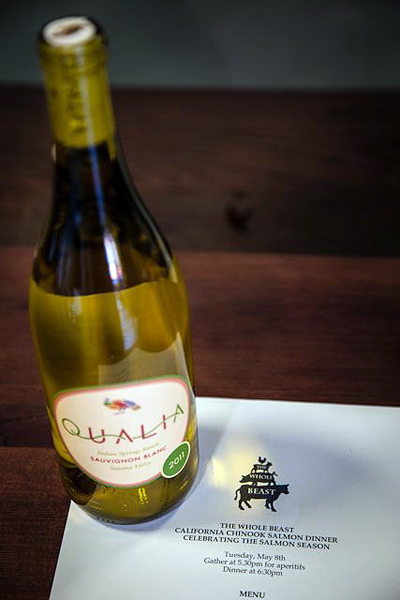Bay area chefs have been serving up funky parts of animals, from pig heart sandwiches at Zazu in Santa Rosa to pig trotter croquettes at Flour + Water in San Francisco, as a way to show respect to the animals we eat. This “Snout to Tail” movement is leading people to embrace the lesser-used parts of cows and pigs and it encourages people to get more adventurous with their eating. For home cooks, it can also be a big money saver to learn how to make stock out of bones or braise tougher cuts.
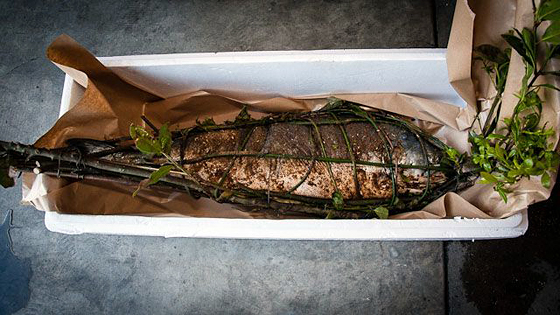
A fourteen pound California Chinook/King salmon from i love blue sea wrapped in branches from a bay laurel tree. Photo: Martin Backhauss
Now there’s a new trend burgeoning, which I am calling “gill to adipose fin,” or using the whole fish. This summer, California is enjoying a strong Chinook salmon comeback. For a fishery that was closed from 2008-2009, and had tepid seasons in 2010-2011, this is a relief for fishermen and boon to salmon lovers. While Chinooks can get very large, averaging 8-20 pounds, buying fish whole and using the entire animal is much more cost effective and environmentally friendly that just making a few prime fillets. As well, you’ll throw creative, multi-course dinner parties, or have meals for a week.
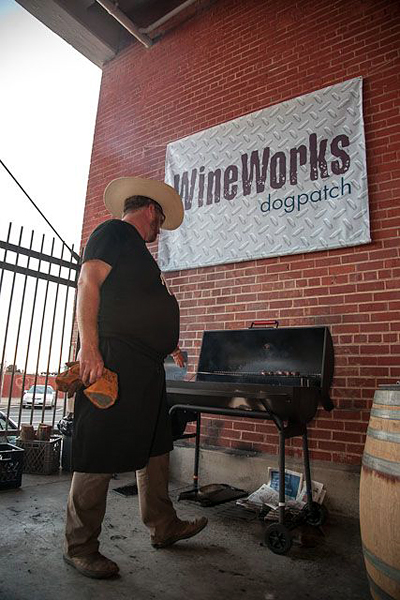
John Fink of The Whole Beast prepares his grill at Dogpatch Wine Works. Photo: Martin Backhauss
An event at Dogpatch Wine Works with John Fink of the Whole Beast, provided a great primer for how to do this. According to John, “Cooking an entire fish means the flavor from the bones and skin are all there.” That night he prepared a beautiful 14-pound California Chinook procured from i love blue sea.
-
He wrapped the king in branches from a bay laurel tree that helped to protect it while roasting. As he cooked, he gave tips on fire building, and ways to prepare all parts of the salmon.
- Make a fire with mild wood, like oak, almond or alder. Start the fire early so you have a good bed of coals to work with.
- Let your fish come up to temperature before preparing, maybe pull it out of the fridge for 15-20 minutes in warm weather, in foggy and cool, leave it out for an hour. This will help it cook more evenly.
- Take the fish outside to scale it, as it can get messy. He then salts the skin twice. The first time he salts aggressively and lets it sit for 15-20 minutes, then rubs it clean. This is to pull out the moisture so it will get crispy; then he re-seasons with salt, fennel powder (seed toasted and ground), black pepper, and porcini powder and let it sit for three hours. After this is grilled, it’s the best “chip” you will ever have.
- The Eggs: Most commercial fishermen gut the fish on the boat for freshness, so to procure these, you’ll have to catch your own fish, buddy up to sport fisherperson, or request these from your local fishmonger. Salmon eggs are fabulous brined or smoked and served in a traditional “caviar” style with crème fraiche and toast or sprinkled on raw oysters. Either way, they make a great appetizer.
- Salmon heads and bones are often oily and take on a very strong flavor, so they aren’t used for soup stocks as commonly as milder whitefish. However, John once worked in a kitchen with a butcher from the Philippines who made a mean salmon head soup. He’d use tomatoes, ginger, tamarind, kaffir lime leaves, potatoes, salmon heads, and water. He’d also add the salmon belly, which many consider the best part of salmon. (Note: Always remove the red gills before using the heads, as the flavor is unpleasant.)
- Salmon collars, the parts right under the head, are on sale at farmer’s markets for about $5.99 a pound. These underrated parts of the salmon have quite a bit of meat on them and John recommends smoking them.
- Belly meat is often called the “cook’s treat” as it’s the fattiest part of the fish, and conventional or factory processors often remove this delicious section from the fillet. When grilling a whole fish and it becomes the richest and most tender piece. Enjoy it like a fillet, or chop it up for rich soups.
- Once you’re ready to grill your whole fish, you will have to trust your instincts a bit. John turns the fish about every 5 minutes for a total of about 4 times. Don’t let it grill for 20 minutes on one side, and then the other, as it will cook too fast and fall apart. Cook it until rare, then remove it from the heat and let it sit for 15-20 minutes, until it’s medium rare; the flesh should be buttery.
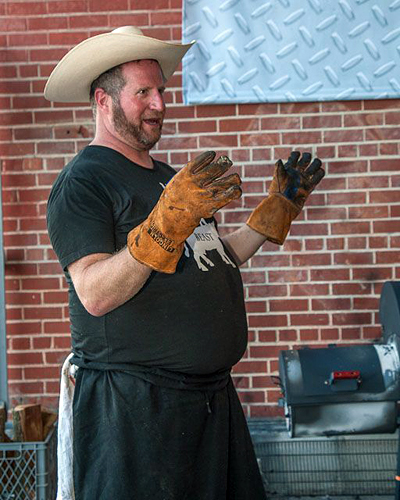
John Fink used to be a commercial fisherman in Alaska, and here he tells fishing stories while working the grill. Photo: Martin Backhauss
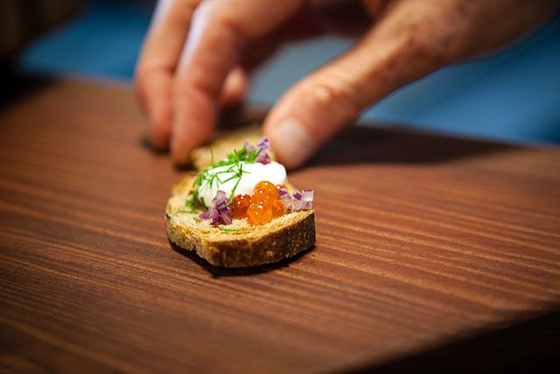
Salmon Caviar with crème fraiche, dill, red onion and served on rye toast. Photo: Martin Backhauss
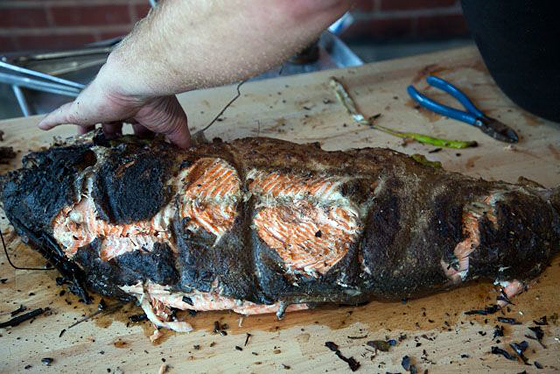
The king salmon is removed from the grill while rare. Guests nibble on the skin as it is left to sit for 15-20 minutes, until it’s brought up to mid-rare. Photo: Martin Backhauss
Qualia wines was pouring at the event, and their Sauvignon Blanc was perfect with the caviar and salmon skin. John plated the California Chinook over wild mushrooms and leeks. He then drizzled it with a red wine reduction made with porcini and a bit of sugar. With all this rich, oily goodness, Qualia’s Syrah Grenache Blend proved perfect.
